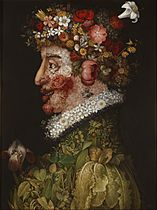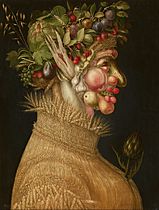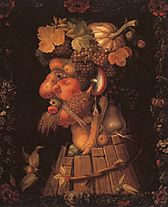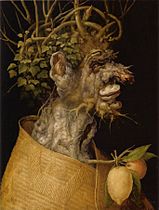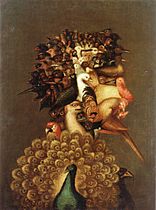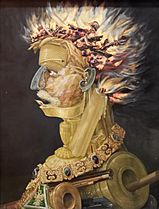Giuseppe Arcimboldo facts for kids
Quick facts for kids
Giuseppe Arcimboldo
|
|
|---|---|
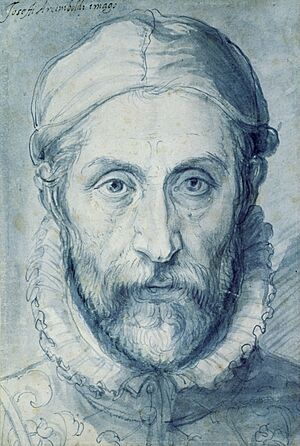
Self-portrait, now in National Gallery Prague
|
|
| Born | 5 April 1527 Milan, Duchy of Milan, Holy Roman Empire
|
| Died | 11 July 1593 (aged 67) Milan, Duchy of Milan, Habsburg Spain
|
| Known for | Painting |
|
Notable work
|
The Librarian, 1566 Vertumnus, 1590–1591 |
Giuseppe Arcimboldo, also spelled Arcimboldi (born 5 April 1527 – died 11 July 1593), was a talented Italian painter. He is famous for his unique and imaginative portraits. These portraits show human faces made entirely of everyday objects. He used things like fruits, vegetables, flowers, fish, and even books to create his art.
Arcimboldo's special portraits are very different from his other artworks. He also worked as a regular court painter for three Holy Roman Emperors. He created religious paintings and drawings of exotic animals. But it's his creative portraits, where objects come together to form human shapes, that people remember most. These artworks were fun and surprising for the royal courts. Today, they still make us wonder about the connection between nature and people.
Who Was Giuseppe Arcimboldo?
A Life in Art
Early Career and Royal Service
Giuseppe's father, Biagio Arcimboldo, was an artist in Milan, Italy. Giuseppe followed in his father's footsteps. He began his art career at just 21 years old. He designed beautiful stained glass and frescoes for local cathedrals.
In 1562, Arcimboldo started working for royalty. He became the official portrait painter for Emperor Ferdinand I. This was at the Habsburg court in Vienna, Austria. Later, he worked for Emperor Maximilian II and his son, Emperor Rudolf II, in Prague. He also designed decorations and costumes for the court. Even important visitors, like Augustus, Elector of Saxony, admired his work. Augustus even ordered copies of Arcimboldo's famous The Four Seasons paintings.
His Unique Style: Portraits of Nature
Arcimboldo's traditional religious paintings are not as well-known today. However, his portraits made from vegetables, plants, fruits, sea creatures, and tree roots were very popular. People loved them in his time, and they still fascinate us now.
From a distance, these portraits look like normal human faces. But if you look closely, you see that each part is made of different objects. These objects are carefully arranged to create human features. For example, in his painting The Librarian, Arcimboldo used items related to books. A curtain forms the body, and animal tails, used as dusters, become the beard.
These artworks were both decorations and still-life paintings. They showed how closely nature and humans are connected.
Messages in His Art
When Arcimboldo's portraits were first shown, some people had strong opinions. For instance, some scholars felt that The Librarian made fun of them. However, Arcimboldo often used his art to share messages about society.
In The Librarian, the painting might look funny. But it also suggested a message about wealthy people. It showed those who collected many books just to own them, rather than to read and learn from them.
Art experts sometimes discuss if his paintings were just playful or if they came from a deeper place. Most scholars believe Arcimboldo was very clever. He understood the Renaissance interest in puzzles and unusual art. His work fit perfectly with the tastes of his time.
Where to See His Art Today
Arcimboldo retired to Milan, Italy, where he later passed away. During his last years, he created more amazing works. These included a portrait of Emperor Rudolph II and his own self-portrait as the Four Seasons. Other Italian artists and writers honored his brilliant career.
Sadly, many of Arcimboldo's paintings were taken during the Thirty Years' War. This happened when the Swedish army invaded Prague in 1648.
Today, you can find his works in many famous museums. These include the Kunsthistorisches Museum in Vienna and the Louvre in Paris. You can also see his art in museums in Sweden, Italy, and the United States. The Real Academia de Bellas Artes de San Fernando in Madrid has his painting The Spring.
Arcimboldo is known as a 16th-century Mannerist painter. Mannerism was an art style that linked the High Renaissance and the Baroque period. Mannerist artists often showed the close relationship between humans and nature. Arcimboldo's portraits truly celebrated nature. For example, in The Spring, a human face is made entirely of flowers and plants. In The Winter, the face is mostly made of tree roots and branches.
Arcimboldo's Lasting Influence
Rediscovery and Modern Art
Arcimboldo's unique art, with its clever images and visual tricks, was rediscovered much later. In the early 20th century, Surrealist artists like Salvador Dalí were inspired by him. An exhibition in Venice in 1987, called "The Arcimboldo Effect," showed many paintings with "double meanings."
Arcimboldo's influence can also be seen in the works of other artists. These include Shigeo Fukuda, István Orosz, and Octavio Ocampo. His style has even appeared in films.
Art and Science
Interestingly, Arcimboldo's works are also used in science. Some psychologists and neuroscientists study his paintings. They use them to understand how our brains recognize different parts of images and objects. This helps them learn about how our brains work.
Famous Artworks
The Four Seasons
-
Spring, 1563, Real Academia de Bellas Artes de San Fernando, Madrid
-
Summer, 1563, Kunsthistorisches Museum, Vienna
-
Autumn, 1573, Louvre, Paris
The Four Elements
-
Fire, Oil on Wood, 1566, Kunsthistorisches Museum, Vienna
Images for kids
-
Vertumnus, a portrait depicting Rudolf II, Holy Roman Emperor, painted as Vertumnus, the Roman god of the seasons, c. 1590–91. Skokloster Castle, Sweden.
-
Four Seasons in One Head, c. 1590, National Gallery of Art, U.S.
-
A 1813 Puzzle Picture of Napoleon, in the style of Giuseppe Arcimboldo, hand-colored etching, in the Cooper Hewitt, Smithsonian Design Museum (New York City)
See also
 In Spanish: Giuseppe Arcimboldo para niños
In Spanish: Giuseppe Arcimboldo para niños
- Art of the late 16th century in Milan
- Jan Brueghel the Elder
- Composite miniature painting
- Hidden faces
- Hide-and-Seek (painting)
- The Librarian (painting)
- Jan van Kessel the Elder


